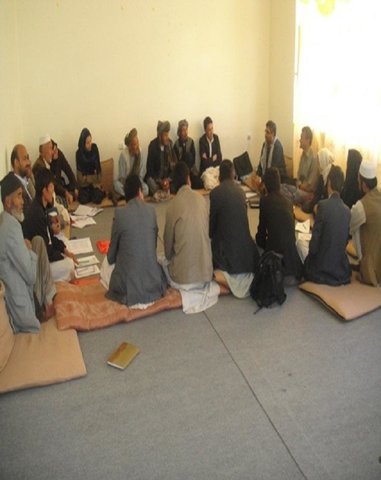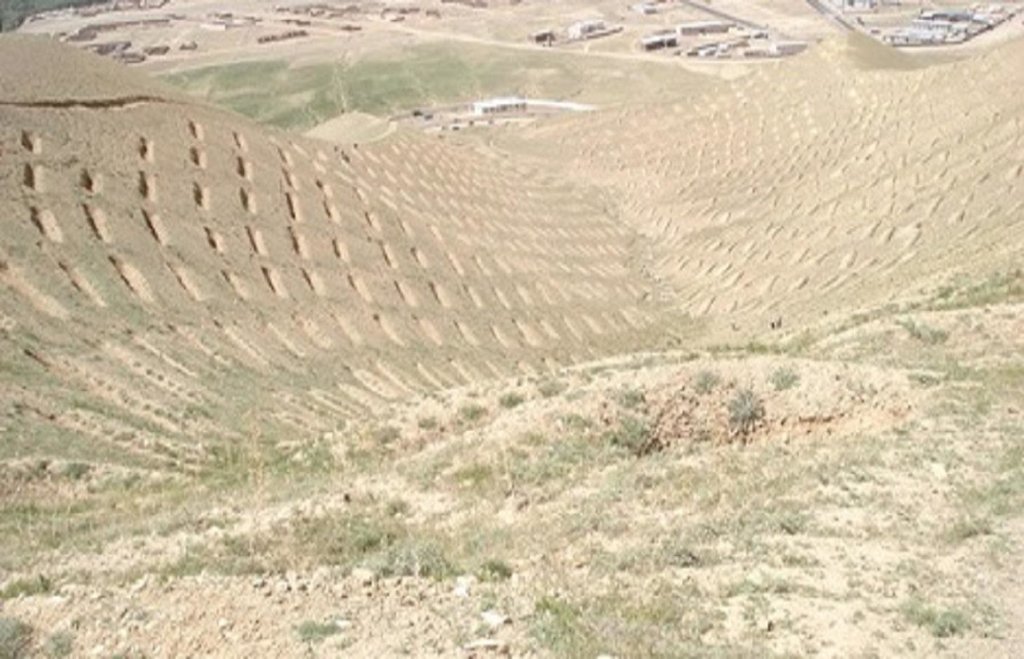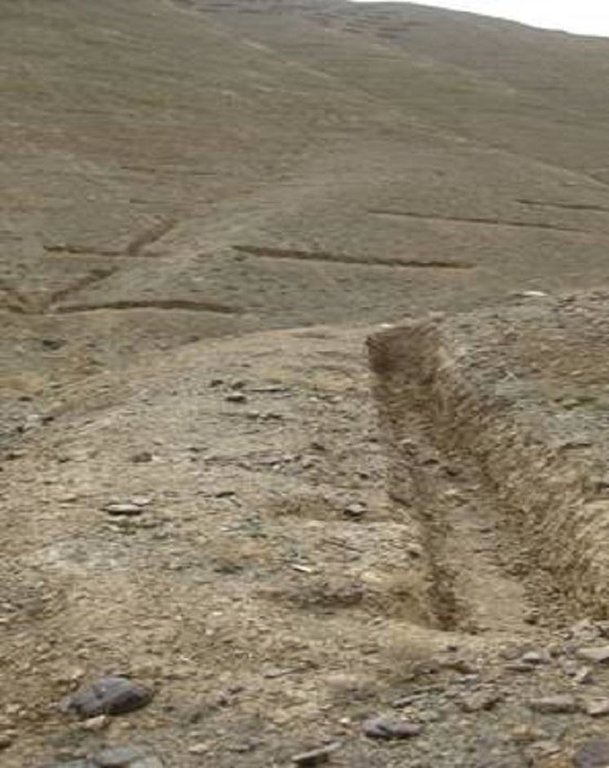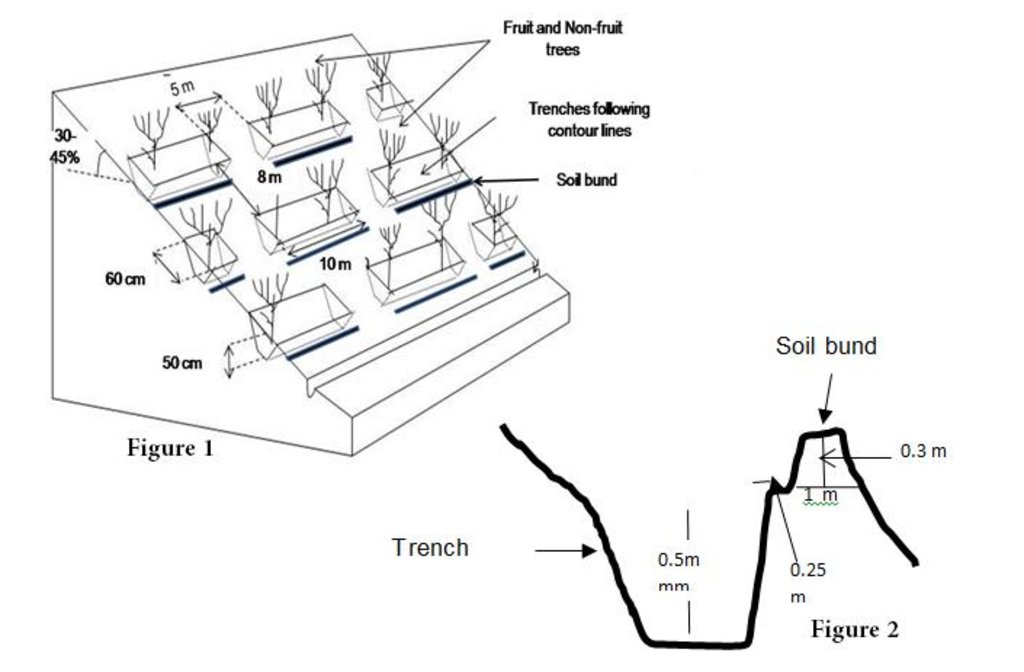Staggered Contour Trench [Afeganistão]
- Criação:
- Atualização:
- Compilador/a: Aqila Haidery
- Editor: –
- Revisor: David Streiff
Jerma (Dari)
technologies_1715 - Afeganistão
Veja as seções
Expandir tudo Recolher tudo1. Informação geral
1.2 Detalhes do contato das pessoas capacitadas e instituições envolvidas na avaliação e documentação da tecnologia
Especialista em GST:
Especialista em GST:
Especialista em GST:
Especialista em GST:
Especialista em GST:
Sirat Aliaver
AKF
Afeganistão
Especialista em GST:
Altaf Jalil
altaf.jalil@akdn.org
AKF
Afeganistão
Nome do projeto que facilitou a documentação/avaliação da Tecnologia (se relevante)
Sustainable Land Management Project, Bhutan (SLMP)Nome da(s) instituição(ões) que facilitou(ram) a documentação/ avaliação da Tecnologia (se relevante)
HELVETAS (Swiss Intercooperation)Nome da(s) instituição(ões) que facilitou(ram) a documentação/ avaliação da Tecnologia (se relevante)
Aga Khan Foundation (AKF) - SuíçaNome da(s) instituição(ões) que facilitou(ram) a documentação/ avaliação da Tecnologia (se relevante)
Sustainable Land Management Institute Organistatio (Sustainable Land Management Institute Organistatio) - Afeganistão1.3 Condições em relação ao uso da informação documentada através de WOCAT
Quando os dados foram compilados (no campo)?
01/10/2015
O/a compilador/a e a(s) pessoa(s) capacitada(s) aceitam as condições relativas ao uso de dados documentados através da WOCAT:
Sim
1.5 Referência ao(s) questionário(s) sobre as abordagens da GST

Community-based Natural Resource Management [Afeganistão]
An approach to community participation in the sustainable management of natural resources
- Compilador/a: Aqila Haidery
2. Descrição da tecnologia de GST
2.1 Descrição curta da tecnologia
Definição da tecnologia:
Earthen trenches with soil bunds built along contours in staggered design
2.2 Descrição detalhada da tecnologia
Descrição:
The SCTs technology is documented by Sustainable Land Management Project/HELVETAS Swiss Intercooperation which is funded by Swiss Agency for Development and Cooperation (SDC), with close support and cooperation of the Agha Khan Foundation (AKF). The staggered Contour Trenches (SCTs) were constructed at a degraded site in Bamyan center (Bamyan province) by Agha Khan Foundation (AKF) project with financial support of the Canadian International Development Agency (CIDA).
Totally 1470 contour trenches were constructed at the site, which has an area of 24 hectares.
The size of each trench measured 10 m in length, 0.6 m in width and 0.5 m in depth. The trenches had soil bunds on the lower side having a width of 1 m and height of 0.3 m. Contour lines were prepared using an A-frame and lime and the spacing between two contour lines was 8 m considering the slope. All the trenches were dug out manually. Local people were employed for construction works. Along with the SCTs, other measures were applied such as plantation of fodder grass, shrub and non-fruit trees, gully plugs, water harvesting tanks and brushwood plugs. The area is excluded from grazing and shrub cutting.
The land was extensive grazing land before the project implementation and got extremely degraded due to a lack of management by the land users. There was rampant exploitation of natural vegetation for meeting domestic energy needs and for grazing. Droughts, which frequently occur in the region, contributed to the slow degradation of the vegetation.
Purpose of the Technology: The main purpose of the technology is to reduce flash flood risks and improve land productivity (both upstream and downstream) so that more fodder, fuel wood and fruits could be produced and farmers affected by flash floods could grow more crops. The technology, which is part of a watershed technology system, helps in retaining runoff and sediment and improves soil moisture content. It also helps in water infiltration which eventually contributes to improved ground water recharge.
Establishment / maintenance activities and inputs: SCTs were established in a step-wise manner; as follows: (1) Site surveying, (2) Site mapping, (3) Planning, (4) Marking contour lines with the help of an A-frame, and (5) Trench excavation and bund construction.
The establishment cost for staggered contour trenches, was about 15,500 USD or 645 USD/ha. Most of the money was spent on labour. There have been no expenses in maintenance of SCTs since their establishment in 2008.
Natural / human environment: The technology is applied in semi-arid condition as the area receives annual rainfall of about 400 mm to address land degradation. The site formally belonged to the state but the local communities have use rights. AKF is still maintaining the site and using it for training and demonstration purpose. Several exposure visits for SLM specialist, land users, students and teachers have been also organized at the site.
2.3 Fotos da tecnologia
2.5 País/região/locais onde a tecnologia foi aplicada e que estão cobertos nesta avaliação
País:
Afeganistão
Região/Estado/Província:
Zai Mahmood village, Bamyan center, Afghanistan
2.6 Data da implementação
Caso o ano exato seja desconhecido, indique a data aproximada:
- menos de 10 anos atrás (recentemente)
2.7 Introdução da tecnologia
Especifique como a tecnologia foi introduzida:
- através de projetos/intervenções externas
3. Classificação da tecnologia de GST
3.1 Principal/principais finalidade(s) da tecnologia
- Melhora a produção
- Reduzir riscos de desastre
3.2 Tipo(s) atualizado(s) de uso da terra onde a tecnologia foi aplicada

Pastagem
Comentários:
Major land use problems (compiler’s opinion): Flash floods, gully/rill/sheet erosion, loss of natural vegetation and low productivity of the land due to degradation compounded by climatic factors.
Major land use problems (land users’ perception): Declining productivity of land resulting in shortages of fodder and fuel wood and loss of fertile land in the downstream areas due to flash floods.
Grazingland comments: The area is closed for livestock.
Future (final) land use (after implementation of SLM Technology): Forests / woodlands: Fp: Plantations, afforestations
Type of grazing system comments: The area is closed for livestock.
Caso o uso da terra tenha mudado devido a implementação da tecnologia, indique seu uso anterior à implementação da tecnologia:
Grazing land: Ge: Extensive grazing land
3.3 Mais informações sobre o uso da terra
Número de estações de cultivo por ano:
- 1
Especifique:
Longest growing period in days: 180; Longest growing period from month to month: April to September
Densidade animal (se relevante):
1-10 LU /km2
3.4 Grupo de GST ao qual pertence a tecnologia
- Reserva ( suspensão do uso, apoio à recuperação)
- Medidas de curva de nível
- Gestão do lençol freático
3.5 Difusão da tecnologia
Especifique a difusão da tecnologia:
- Uniformemente difundida numa área
Caso a tecnologia seja uniformemente difundida numa área, indique a área coberta aproximada:
- 0,1-1 km2
Comentários:
Total area covered by the SLM Technology is 0.24 km2.
3.6 Medidas de GST contendo a tecnologia

Medidas estruturais
- S4: Valas de nível, fossos
3.7 Principais tipos de degradação da terra abordados pela tecnologia

Erosão do solo pela água
- Wt: Perda do solo superficial/erosão de superfície

Degradação biológica
- Bc: redução da cobertura vegetal

Degradação da água
- Hs: mudança na quantidade de água de superfície
Comentários:
Main causes of degradation: deforestation / removal of natural vegetation (incl. forest fires), over-exploitation of vegetation for domestic use, overgrazing
3.8 Redução, prevenção ou recuperação da degradação do solo
Especifique o objetivo da tecnologia em relação a degradação da terra:
- Reduzir a degradação do solo
4. Especificações técnicas, implementação de atividades, entradas e custos
4.1 Desenho técnico da tecnologia
4.2 Especificações técnicas/ explicações do desenho técnico
A detailed staggered contour trenches layout and its specifications (Fig. 1), and the cross section of soil bunds (Fig. 2)
Location: Bamyan. Bamyan center/Bamyan province
Technical knowledge required for land users: high
Technical knowledge required for SLM specialist: high
Main technical functions: control of dispersed runoff: retain / trap, increase of infiltration, sediment retention / trapping, sediment harvesting, increase of biomass (quantity), promotion of vegetation species and varieties (quality, eg palatable fodder)
Secondary technical functions: reduction of slope length, improvement of ground cover, increase in organic matter, increase / maintain water stored in soil, improvement of water quality, buffering / filtering water, spatial arrangement and diversification of land use
Retention/infiltration ditch/pit, sediment/sand trap
Spacing between structures (m): 8
Bund/ bank: level
Spacing between structures (m): 8
Height of bunds/banks/others (m): 0.5
4.3 Informação geral em relação ao cálculo de entradas e custos
Especifique como custos e entradas foram calculados:
- por área de tecnologia
Indique o tamanho e a unidade de área:
1 ha
Especifique a moeda utilizada para os cálculos de custo:
- Dólares norte-americanos
4.4 Atividades de implantação
| Atividade | Tipo de medida | Periodicidade | |
|---|---|---|---|
| 1. | Digging of the contour trenches and construction of the soil bunds | Estrutural | |
| 2. | Marking contour lines (A frame and lime) | Estrutural |
4.5 Custos e entradas necessárias para a implantação
| Especifique a entrada | Unidade | Quantidade | Custos por unidade | Custos totais por entrada | % dos custos arcados pelos usuários da terra | |
|---|---|---|---|---|---|---|
| Mão-de-obra | Digging of the contour trenches and construction of the soil bunds | persons/day/ha | 100,0 | 6,43 | 643,0 | |
| Equipamento | A frame and lime | ha | 1,0 | 1,8 | 1,8 | |
| Custos totais para a implantação da tecnologia | 644,8 | |||||
Comentários:
Duration of establishment phase: 4 month(s)
4.6 Atividades recorrentes/manutenção
| Atividade | Tipo de medida | Periodicidade/frequência | |
|---|---|---|---|
| 1. | No maintenance activities have been implemented for staggered contour trenches and soil bunds up to now. | Estrutural |
4.8 Fatores mais importantes que afetam os custos
Descreva os fatores mais determinantes que afetam os custos:
Despite the application of the structural measure of the SCTs AKF is still continuing its financial support for the plantation of the area. Thus irrigation which is a costly activity is still continued by AKF's support. The planted saplings of fruit and non-fruit trees are irrigated for six months/year, i.e. from April to September. Water is carried to the site by tankers. Each month, 75 tankers are used and the cost of one tanker is 12 USD or 600 Afghani. In addition, 16 persons are employed for one time irrigation.
5. Ambiente natural e humano
5.1 Clima
Precipitação pluviométrica anual
- <250 mm
- 251-500 mm
- 501-750 mm
- 751-1.000 mm
- 1.001-1.500 mm
- 1.501-2.000 mm
- 2.001-3.000 mm
- 3.001-4.000 mm
- > 4.000 mm
Especificações/comentários sobre a pluviosidade:
Bamyan receives heavy snow falls and rain falls in winter season
Zona agroclimática
- Semiárido
Thermal climate class: temperate
5.2 Topografia
Declividade média:
- Plano (0-2%)
- Suave ondulado (3-5%)
- Ondulado (6-10%)
- Moderadamente ondulado (11-15%)
- Forte ondulado (16-30%)
- Montanhoso (31-60%)
- Escarpado (>60%)
Formas de relevo:
- Planalto/planície
- Cumes
- Encosta de serra
- Encosta de morro
- Sopés
- Fundos de vale
Zona de altitude:
- 0-100 m s.n.m.
- 101-500 m s.n.m.
- 501-1.000 m s.n.m.
- 1.001-1.500 m s.n.m.
- 1.501-2.000 m s.n.m.
- 2.001-2.500 m s.n.m.
- 2.501-3.000 m s.n.m.
- 3.001-4.000 m s.n.m.
- > 4.000 m s.n.m.
5.3 Solos
Profundidade do solo em média:
- Muito raso (0-20 cm)
- Raso (21-50 cm)
- Moderadamente profundo (51-80 cm)
- Profundo (81-120 cm)
- Muito profundo (>120 cm)
Textura do solo (solo superficial):
- Grosso/fino (arenoso)
Matéria orgânica do solo superficial:
- Baixo (<1%)
Caso disponível anexe a descrição completa do solo ou especifique as informações disponíveis, p. ex. tipo de solo, PH/acidez do solo, nitrogênio, capacidade de troca catiônica, salinidade, etc.
Soil fertility is very low - low
Soil drainage / infiltration is oor due to sealing
Soil water storage capacity is low
5.4 Disponibilidade e qualidade de água
Lençol freático:
> 50 m
Disponibilidade de água de superfície:
Precário/nenhum
Qualidade da água (não tratada):
apenas para uso agrícola (irrigação)
5.5 Biodiversidade
Diversidade de espécies:
- Baixo
5.6 Características dos usuários da terra que utilizam a tecnologia
Orientação de mercado do sistema de produção:
- Subsistência (autoabastecimento)
- Misto (subsistência/comercial)
Rendimento não agrícola:
- 10-50% de toda renda
Nível relativo de riqueza:
- Média
Indivíduos ou grupos:
- Empregado (empresa, governo)
Indique outras características relevantes dos usuários da terra:
Difference in the involvement of women and men: Mainly men were involved in the activities due to cultural reasons.
Population density: 10-50 persons/km2
Annual population growth: 3% - 4%
100% of the land users are average wealthy.
Off-farm income specification: This is more applicable for poor small landholders or landless families.
5.7 Média da área de terra própria ou arrendada por usuários da terra que utilizam a tecnologia
- < 0,5 ha
- 0,5-1 ha
- 1-2 ha
- 2-5 ha
- 5-15 ha
- 15-50 ha
- 50-100 ha
- 100-500 ha
- 500-1.000 ha
- 1.000-10.000 ha
- > 10.000 ha
5.8 Propriedade de terra, direitos de uso da terra e de uso da água
Propriedade da terra:
- Estado
Direitos do uso da terra:
- Acesso livre (não organizado)
Direitos do uso da água:
- Acesso livre (não organizado)
Comentários:
Formally, state owned. The site is now protected from open grazing and shrub cutting with support from the local communities.
5.9 Acesso a serviços e infraestrutura
Emprego (p. ex. não agrícola):
- Pobre
- Moderado
- Bom
Mercados:
- Pobre
- Moderado
- Bom
Energia:
- Pobre
- Moderado
- Bom
Vias e transporte:
- Pobre
- Moderado
- Bom
6. Impactos e declarações finais
6.1 Impactos no local mostrados pela tecnologia
Impactos socioeconômicos
Produção
Produção de forragens
Qualidade da forragem
Produção animal
Risco de falha de produção
Diversidade de produtos
Área de produção
Comentários/especificar:
Decreased production area
Disponibilidade e qualidade de água
Disponibilidade de água para criação de animais
Renda e custos
Rendimento agrícola
Impactos socioculturais
Segurança alimentar/auto-suficiência
Estado de saúde
Oportunidades culturais
Comentários/especificar:
As the site is greener now
Oportunidades de lazer
Instituições nacionais
Comentários/especificar:
Especially of DAIL (Department of Agriculture, Irrigation and Livestock) and the persons who visit the site
Conhecimento de GST/ degradação da terra
livelihood and human well-being
Impactos ecológicos
Ciclo hídrico/escoamento
Colheita/recolhimento de água
Comentários/especificar:
Runoff, dew, snow, etc.
Escoamento superficial
Lençol freático/aquífero
Solo
Cobertura do solo
Biodiversidade: vegetação, animais
Diversidade vegetal
Diversidade animal
Controle de praga/doença
Clima e redução de riscos de desastre
Risco de incêndio
6.2 Impactos externos mostrados pela tecnologia
Cheias de jusante
Sedimentação a jusante
Sedimentos transportados pelo vento
Comentários/especificar:
Due to better vegetation cover
6.3 Exposição e sensibilidade da tecnologia às mudanças climáticas graduais e extremos/desastres relacionados ao clima (conforme o ponto de vista dos usuários da terra)
Mudança climática gradual
Mudança climática gradual
| Estação do ano | Tipo de mudança climática/extremo | Como a tecnologia lida com isso? | |
|---|---|---|---|
| Temperatura anual | aumento | bem |
Extremos (desastres) relacionados ao clima
Desastres meteorológicos
| Como a tecnologia lida com isso? | |
|---|---|
| Tempestade de vento local | bem |
Desastres climatológicos
| Como a tecnologia lida com isso? | |
|---|---|
| Seca | bem |
Desastres hidrológicos
| Como a tecnologia lida com isso? | |
|---|---|
| Inundação geral (rio) | não bem |
Outras consequências relacionadas ao clima
Outras consequências relacionadas ao clima
| Como a tecnologia lida com isso? | |
|---|---|
| Período de crescimento reduzido | bem |
Comentários:
SCT must be combined with vegetation and management measures
6.4 Análise do custo-benefício
Como os benefícios se comparam aos custos de implantação (do ponto de vista dos usuários da terra)?
Retornos a curto prazo:
levemente positivo
Retornos a longo prazo:
muito positivo
Como os benefícios se comparam aos custos recorrentes/de manutenção(do ponto de vista dos usuários da terra)?
Retornos a curto prazo:
positivo
Retornos a longo prazo:
muito positivo
Comentários:
The benefits stated are the combined impacts of all measures-structural, vegetative and management. SCTs have helped in the establishment of vegetative measures by contributing to increased soil moisture, reduced runoff and soil loss.
6.5 Adoção da tecnologia
Entre todos aqueles que adotaram a tecnologia, quantos adotaram espontaneamente, ou seja, sem receber nenhum incentivo material/pagamentos?
- 0-10%
Comentários:
Comments on acceptance with external material support: The whole project activities were implemented by external supports
There is no trend towards spontaneous adoption of the Technology
Comments on adoption trend: As the implementation of a watershed project requires high costs and investments which can not be affordable for the individual land users.
6.7 Pontos fortes/vantagens/oportunidades da tecnologia
| Pontos fortes/vantagens/oportunidades na visão do usuário da terra |
|---|
| The land users views were not considered. |
| Pontos fortes/vantagens/oportunidades na visão do/a compilador/a ou de outra pessoa capacitada |
|---|
|
Helps in reducing flash flood risks due to less runoff How can they be sustained / enhanced? Proper institutional mechanisms, involving the government, non-government and community institutions should be developed for sustaining project activities. Department of Agriculture, Irrigation and Livestock DAIL; (Bamyan) should take lead |
|
Conserves soil and enhances soil cover and fertility leading to more on-site production How can they be sustained / enhanced? Vegetative measures should be strengthened |
| Complements re-greening efforts by reducing erosion and conserving moisture |
| The quality of contour trenches and soil bunds are very good and maintenance costs negligible |
| The site is used for demonstration, training and exposure visits |
6.8 Pontos fracos, desvantagens/riscos da tecnologia e formas de superá-los
| Pontos fracos/vantagens/riscos na visão do/a compilador/a ou de outra pessoa capacitada | Como eles podem ser superados? |
|---|---|
| Establishment costs are very high | Voluntary community contributions, if they have an active stake in the project, would reduce the costs, otherwise, there has to be external support at least for the establishment phase |
| Loss of land for production | Planting suitable plants inside the trenches and along soil bunds |
| Requires high level of technical knowledge for establishment | Practical training for the target groups |
Links e módulos
Expandir tudo Recolher tudoLinks

Community-based Natural Resource Management [Afeganistão]
An approach to community participation in the sustainable management of natural resources
- Compilador/a: Aqila Haidery
Módulos
Não há módulos





